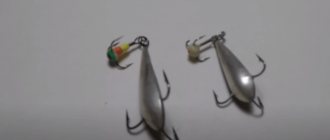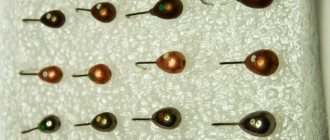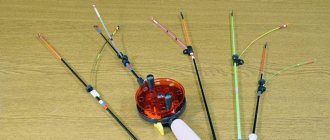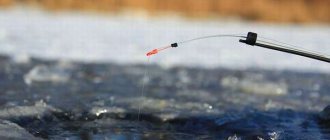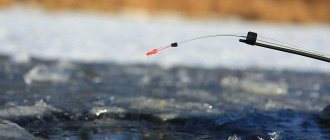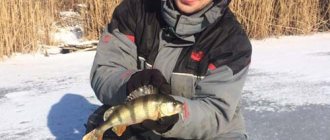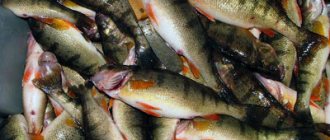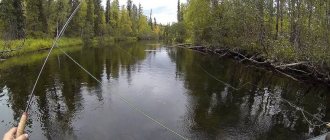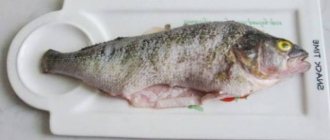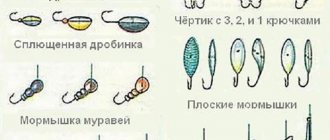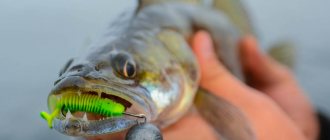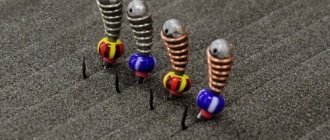Summer jig in autumn
Recently, fishing with a side nod, or “summer jig,” has been discussed quite often in periodicals, but the emphasis is mainly on fishing in the spring or summer season. Indeed, many fishermen associate this type of fishing with the spring-summer period. I will say even more - there is a certain contingent of fishermen who fish with a side nod only in the spring, considering summer fishing to be less productive, and let alone the fall. And completely in vain!
The further autumn comes into its own, the less often good weather happens. Strong and already cold winds are blowing more and more often, and it is raining for a long time. At such times, fishing with a side nod takes on a somewhat extreme coloring, but the result is worth it. In tactical terms, it should be noted that in inclement weather you should look for fish on the edges, in coastal holes. Such places are most often accessible when fishing “in the wade” and with fairly long rods (up to 9 meters).
It is important to note that in windy weather the balance of the entire tackle is especially important. The rod should be quite light and rigid, the nod should seem to cut through the wind and not react to its gusts in order to eliminate false bites, the diameter of the fishing line should be the minimum possible to reduce its windage.
What’s good about fishing with a side nod is its versatility and democracy. Some people fish with “dead” equipment, others with “running” equipment (with a reel), but these are the personal preferences of each angler, which can be determined either by the specifics of the reservoir, or the object of fishing, or even by the fact that “I like it.” more likely".
As for our main bait - the jig, in the fall the range of use of its varieties expands. These can be “goats”, “devils” and various “locomotives” made from two jigs. The choice of a specific jig or “devil”, including the color of the bait, is determined by the characteristics of a particular body of water. So try to experiment more with different types of baits, their colors, and then it will be easier for you to determine the “catchability” of a particular jig. For beginners, I would recommend, as the most versatile, jigs such as “Uralka”, “drop” and “ant” of black (dark) color.
The size and, accordingly, the weight of the jig is selected based on the fishing conditions. Most jigs for almost every taste are made of lead. Tungsten jigs are required for fishing at depth, or when you need a small jig size with sufficient weight.
Just like in the summer, for those who like to fish with bait, the main baits are bloodworms, maggots, and pieces of worm. For “mothless fishers,” various combinations of colored cambrics and beads are used as attachments. A piece of foam rubber is often used as a refill. Recently, the so-called “artificial bloodworm” has become widespread. It looks very similar to the real one, but it holds better on the hook and shows good results.
FISHING AND OBJECTS OF FISHING
In autumn, perch is especially active. This is perhaps the main object of hunting with a side nod at this time. It is caught more often; during the feast, it often comes out close to the coastline, especially if there are edges nearby. And the size of the autumn perch can please you. Fishing for a “combat” perch weighing more than 250 grams, and even with thin tackle, brings pleasant moments of struggle, although in the fall you often come across real “humpbacks”.
Another important point when catching perch in the fall is fishing “for the game.” Autumn is exactly the time when an angler can learn this method of fishing with a side nod, believe in an “empty” jig, and feel the fishing “for the game.” Instead of bloodworms, small colored cambrics or beads are put on the hook of the jig; also in the fall, all sorts of “devils” and “goats” work very well. Of course, many fishermen fish this way in other periods, and often quite successfully, but for those who want to learn how to fish with a reelless bait, autumn and perch are the most favorable combination for mastering this fishing method. I will not describe the different ways of playing, since even simple vertical wiring with micro-pauses works. Well, then you just experiment with pauses, the frequency and amplitude of twitching of the rod tip, different speeds of lifting the jig, and you will soon feel for yourself what kind of retrieve and game the perch most often responds to. The good thing about fishing with a side nod is that there are practically no dogmas when fishing, and experimentation comes first on literally every new fishing trip.
Finding an active perch in a pond is quite simple - by its characteristic fight. Make a line in this place from the very bottom to the surface, and the bite will not be long in coming. Typically, larger perch are closer to the bottom, and even if you have a lot of bites at half-water and above, then periodically make movements from the very bottom. When fishing for perch, the “locomotive” type rig is used quite successfully - when another one is tied above the main jig (15-20 cm), on the hook of which there are decoys in the form of cambrics and beads. Perch responds well to this type of equipment and very often, when the bite is active, they are caught using two jigs at once. Sometimes when fishing with a “locomotive”, a “devil” is used instead of a lower jig.
As for catching fish such as roach and bream, the following can be noted. The colder the water, the further the fish move from the shore, and they gather in large schools. When fishing, knowledge of the reservoir comes first - where the coastal holes and the so-called “fish trails” are located. If the reservoir is unfamiliar, only an active search can help in identifying the locations of roach and bream. When the bite is active, roach and bream are also well caught using the “game”.
Successful crucian carp fishing in the fall usually depends heavily on the weather. If the weather is warm, crucian carp can be successfully caught using bloodworms almost throughout September. In unstable weather and sharp temperature fluctuations, as well as significant cooling of the water, crucian carp fishing is more sporadic. Such capricious crucian carp can be caught, most often, only in crucian ponds, and even then you have to wait quite a long time for the next release. Therefore, it is better to switch to catching other fish at such times.
In autumn, the issue of equipment for fishing with a side nod is especially acute. It is ideal to have waders or waders made of neoprene - this is the material that retains maximum heat in cold water, but, unfortunately, this pleasure is not cheap. If you have ordinary rubber waders or waders, then you need to think about good insulation. Previously, wadded trousers were a great success, but they are quite heavy, and if you sweat in them, say, during transitions, or, God forbid, accidentally flood them, then all the comfort and pleasure from fishing will disappear. In my experience, I recommend wearing Polartec trousers, ideally overalls. The fundamental difference of this modern material is that even when wet it retains heat and dries quickly in the open air. The outer part of clothing should be made of several layers. I use the following combination - thermal underwear, then a pullover made of Polartec material and a “breathable” waterproof jacket, always with a hood. If you need more insulation, then wear a down or padding polyester vest between the jacket and the pullover. They usually put on their feet the same “Polartek” socks or thermal socks, of which there are a lot on sale now. It is also important that such socks are usually made using seamless technology and are very comfortable when worn in boots. And the last thing: even if you don’t freeze when wading in cold water, you still need to periodically go ashore and at least warm up a little.
Autumn roach and jig
How and what to catch roach in autumn
In autumn, during a period of significant cooling of the water, roach feeds almost exclusively on living organisms that live in the water or enter it from the external environment. At this time, a fishing rod with a side nod and a jig is best suited for fishing.
Since roach often stays on deep edges in the fall, a 6-8 meter lightweight rod is chosen for jig fishing. This rod allows you to easily manipulate the tackle and does not tire the angler for a long time. A fishing rod with a side nod and a jig is used to fish from the shore or wade, sometimes using rubber overalls. Four to five meter rods are convenient for fishing from a boat.
The rod whip must be rigid and have a diameter of 1.5-2 mm in order for the side nod to rest securely on it. The nod plate is usually longer than for bass fishing. The tip of the nod is painted red or a brightly colored ball with a ring for fishing line is mounted on it.
Depending on the weight of the jig and the fishing conditions, summer nods vary in length and width. In my box I have nods from 20 to 40 cm long and a width at the base of the plate from 8 to 30 mm. The narrowest but longest nods are used for light jigs and fishing in calm waters. The nod plate is cut into a cone. For fishing on ponds, a nod is well suited, the plate of which is 30 cm long, 2 mm wide at the tip, and 8 mm wide at the base. For fishing in the current, you can take a shorter nod with a wider base.
For autumn roach, the most commonly used jigs are “uralka”, “ant”, “ovsinka”, “pellet”, “droplet” - of different sizes, but not too large. Hooks - with long or medium hook, No. 18-15. Practice has shown that gray and black baits are good in any weather and depth. On cloudy days and at greater depths, sometimes light-colored jigs are more catchy.
If changing your playing style does not help for a long time, you need to change the jig. In the fall, it happens that flat and flat-oval jigs work well, with which you need to play under coastal shelters (crowns of bushes, trees that have fallen into the water, etc.) from the surface towards the bottom.
I often glue tiny strips, ovals, and circles of multi-colored foil onto jigs. I use fast-hardening waterproof glue. A white, matte, flat-oval jig with a black foil zebra glued to the bottom works well when fishing under coastal shelters. Also, in various conditions, both when playing near the bottom and in higher layers of water, the black “Uralka” with transverse rings made of yellow foil has proven itself to be excellent. Sometimes it is enough to stick one or two lighter tiny spots on a gray or black jig like “ant” or “droplet”. For example, a silver stain will suit a lead jig, and a matte stain will suit a black jig. If the jig is large enough, several light spots can be scattered throughout its body.
The best bait for a jig is a small underleaf worm or some other red worm, the larva of a bark beetle. These baits are familiar to roaches in the fall, as they often fall into the water.
The line must be strong. On some large reservoirs, for example, on the Oka, Mologa, and Rybinsk Reservoir, roaches weighing half a kilogram or more are often pecked, which easily tear a fishing line with a diameter of 0.18 mm. In order for the jig to naturally play with “rough” tackle, it must pull out the monofilament with its weight. Therefore, for fishing line thicker than 0.16 mm, you have to use heavy tungsten jigs.
In autumn, most of the time is spent searching for fish that are local, and you can walk long distances along the shore before you find a concentration of roach. But even in a concentrated area, the fish may not bite, especially with constantly changing pressure. Sometimes you know for sure that a fish is standing here, but it doesn’t reveal itself. You change the game, suddenly knock-knock - light blows on the jig, without changing the amplitude and rhythm, made the retrieve a little faster - a bite. The vibrations must correspond to the size of the nozzle. Strong vibrations can spook the fish.
Catching roach with a fishing rod with a side nod and a jig is carried out not only on deep edges, but also near islands of wilted algae, behind accumulations of leaves that have fallen on the water, near flooded bushes. Living organisms always gather in such areas, and roaches often come here to feed.
When moving along the shore or using a boat, you often have to swim long distances and fish various attractive areas until you come across a roach outlet. And in the fall, schools of roach are sometimes very large.
More about autumn baits. I prepare many of them in advance. At pond dams below the spillways there are piles of limestone-type stones, which are often pierced by small holes. Pond caddis flies live in these holes. Its larvae are very small; they are usually put on a hook in several pieces. To catch caddis flies, these stones must be taken out of the water and left on the shore. After the stones dry, the caddis fly itself will begin to crawl out of its holes. On the same stones you can find small crustaceans (no more than one and a half centimeters long), resembling woodlice, but with a hard shell. When catching large roach and crucian carp, it is best to put them on in three pieces over the middle of the body.
On ponds and reservoirs, it is good to catch crustaceans and caddis flies near thickets of young sedge, also below dams, on rivers - on riffles and where fast water comes close to sedge or washed away rhizomes of bank vegetation. Any river fish takes well on large caddis flies. True, practice has shown that on rivers such as the Sherna and Tarusa near Moscow, fish often prefer to take a stationary caddisfly (in this case, the jig lies on the bottom or touches it).
Another catchy bait is the brown caterpillar, which is found together with the larva of the burdock moth in the stems of the Chernobyl plant. Its length is approximately 2 cm. Large roaches sometimes bite on this bait.
Playing technique
Depending on the season, when fishing with a jig, different techniques for playing with it are used.
in winter
When ice fishing, the following types of jig play are practiced:
- Uniform rise with oscillations and pauses - the jig rises from the bottom with smooth low-amplitude oscillations with 2-3 second pauses every 40-50 cm of rise;
- Uniform rise without hesitation with pauses - the execution technique is similar to the previous wiring with the difference that during the rise the bait is not given vibrations by nodding
- Reverse wiring - the bait raised 0.6-1.0 m above the bottom is lowered onto the bottom soil with smooth and low-amplitude oscillations;
- “ Knock on the bottom” - the jig is raised above the bottom by 2-3 cm, after which, sharply lowering the fishing rod, they allow it to quickly fall back to the bottom soil. After repeating such manipulations 2-3 times, and raising a cloud of turbidity at the place where the jig falls to the bottom, the bait is lifted above the bottom and held motionless for some time. A roach located nearby, reacting to the turbidity during such wiring, as a rule, grabs the jig with bait located inside it.
When fishing with a reelless bait, use uniform fishing with high-frequency oscillations and pauses every 30-40 cm of lift.
.
On open water
During the open water season, two main techniques for playing with a jig are used:
- On the rise - the jig is lowered to the bottom, and then, with smooth and rare vibrations, the nod is raised to the subsurface layer. Bites with this type of fishing occur in mid-water or at its very surface.
- To lower - the bait is smoothly lowered to the bottom, periodically giving it smooth vibrations. The main part of bites during this game occurs in the middle layers of water.
Video on catching roach with jigs
Spring fishing:
Winter fishing for large trophies:
Fishing with a jig in the fall
The float rod is a frozen fish and does not like cold periods in the fall, when catches sharply decrease. But the fish simply react wonderfully to the jig, and the colder it is, the better!
In the fall, I always take three five-meter fishing rods with guides into the boat - two float rods, one jig with a nod. I have a dozen small wire reels with fishing lines from 0.12 to 0.3 mm in stock; I select the required strength of the gear according to the situation, placing one or another reel, most often 0.18 mm is universal. I’m starting to feel the bite with the float.
If I go, I don’t even lay out the jig rod; but when something is wrong, I only fish with a jig, covering the floats. Why is fish caught with a jig, rejecting the float hook when using the same bait?
Of course, the point is not that the jig somehow additionally attracts frozen underwater inhabitants. It’s just that in the fall, the fish are often tightly packed into the cane, reluctantly moving from their “home” place towards clean water, where complementary food is provided, this is especially true for autumn crucian carp. Here he is, the cunning one, pushing the reeds with his wide back, but it’s impossible to throw a float here without a hook! Then I slowly lower the jig vertically - there’s a bite!
He slipped it under his nose, so a grip is almost inevitable, just like with a spinning predator. But playing along with a jig is useless, and at times even harmful - in the fall the fish takes a slow descent, the same rise without hesitation, and even on a riser when the jig is frozen at the bottom or slightly higher.
Therefore, the simplest nod is suitable, its task is not to give away some fancy game, but to simply be a reliable watchdog, noting careful bites, touching algae with a jig, and not dangling too much in the wind.
A jig is a real lifesaver on those days when the fish reacts poorly to bait. Then I’m always searching: I’ll fish everything around the boat, swim across, walk around in a circle again, and so on, warming up with active fishing and slowly filling the fish tank.
When fishing each place, I quickly check the entire thickness of the water with a jig, because the bites are not only from the bottom, but also half-water, and even very close to the surface, especially on sunny days. The jig perfectly plays the role of a kind of echo sounder - working vertically, I quickly find mini-pits, tubercles, snags, stones - places where it is worth staying longer, waiting for a bite.
Technique for catching perch with a jig
Winter fishing using jigs begins with drilling 5-10 holes in the ice. In each hole you need to make 5-6 wires, using the entire vertical. Usually the jig is lowered to the bottom, after which there is a short pause. With a small number of bites, it is necessary to perform the wiring evenly and monotonously.
Despite the lack of pickiness in choosing food, perch can be biased towards playing jigs under the hole. With good activity, the fish reacts to any behavior of the bait, so there is no need to put much effort into the fishing process. A beginner just needs to follow these instructions:
- When the jig is at the bottom, you need to lift it with a nod by 20-30 cm, making moderate vibrations, and then lower it again.
- After tapping the bait on the bottom several times, you need to raise it again by 5-6 cm, pause and return the product back to the bottom.
- Then you should evenly raise the jig to a height of 20 cm and tap the whip with your finger.
There are a large number of variations of the jig game, but the mentioned option is considered a “classic of the genre” and justifies itself in most cases.
Catching perch with a jig from the ice is an interesting process that gives anglers great pleasure. But in order not to leave the reservoir without a catch and mood, it is important to pay attention to many aspects of this trend in fishing.
Catching perch in the fall with a jig, bait bait, spinning rod and fishing rod
Catching perch in the fall with a jig, bait, spinner and fishing rod is not an easy task. Read our article on how to fish correctly at this time.
Very often when fishing for perch in the fall, fishermen encounter problems. The fish stop biting where they were abundant yesterday. There are many explanations for this. For example, changes in atmospheric pressure and temperature or changes in wind direction. What affects the autumn perch bite? In the fall, the marten senses even the slightest weather changes in advance and swims away from the coastal zone. And as soon as the weather improves, the perches again, along with the adults, appear near the shore. With a slight wind, ripples appear on the water, which perch loves very much, because... you can move much more boldly in a body of water. But a factor such as blooming of a reservoir can cause the perch to stop biting in the fall.
Selection of baits for perch in the fall
Silicone baits are popular baits for perch fishing. These can be twisters or vibrotails. Today in fishing stores you can
choose any silicone baits. Pay special attention to the quality of the material from which they are made. Based on their hardness, silicone tips can be divided into soft, soft, medium hard and hard. The choice of bait depends on what kind of fish you are going to catch. Do not purchase an overly soft silicone nozzle, because... the sharp teeth of a perch can easily render it unusable, and when hooking it, you can accidentally tear it. When purchasing a silicone bait for perch fishing, consider the quality of the material from which it is made.
For example, when choosing a vibrating tail, take the nozzle with 2 fingers in the area of the head and lift it upward with the tail. With such manipulation, the tail of the nozzle should tilt at a right angle. The sensitivity of the silicone bait depends on the angle. If the tail part of the nozzle does not tilt well, then you will need to finish it yourself by removing the interfering part of the nozzle. You can also use heat to solve this problem. But it’s better if you buy a high-quality silicone bait for catching perch in the fall.
Perch fishing in September
In this autumn month, perch prefers to be in schools. This fish can be caught near the shore and in deep holes of the reservoir. When the season's temperature drops, the water becomes clearer. Because of this phenomenon, perch are particularly picky in choosing silicone baits.
To catch perch in September, you need to choose deep holes with warm water. Most often at this time of year there are perches from 70 to 100 grams. There are certain colors of silicone baits that are considered the most catchy: 1. Brown silicone bait with silver speckles. 2. Silicone nozzle of green or light green color. 3. Silicone nozzle of pearl or purple color. 4. Almost transparent silicone nozzle. 5. White silicone nozzle with green and red dots.
If you have chosen the right bait for fishing for perch in the fall, then the bite will be throughout the day with a pause from 13 to 15 hours.
Fishing for perch in October
In October, the nights become even colder, which provokes a decrease in the frequency of biting in the morning. With the advent of wind and sunny daytime heat, the bite begins again. In the middle of the month, fish can be found in pits. Even the slightest change in weather can affect the bite. The main bite begins around 11 am. There can be no more than three fishing spots in a reservoir in October; it is especially common in the grass.
Remember that you need to dress warm enough for October fishing. Consider one more point: you need to cast silicone baits over a long distance, looking for places where fish accumulate.
How to catch perch in November
When real cold sets in and the temperature drops to sub-zero, the perch bites end. And they begin again when the reservoir is covered with ice and the fish get used to this temperature. If the reservoir does not freeze for a long time, perch can be caught in sunny weather during the day, especially at midday.
You can watch the video on how to bait and other secrets about catching perch in the fall. It will answer many of your questions.
Catching pike perch with a diverting leash in the current
Weather for pike fishing
Autumn fishing in September for pike crucian carp perch pike perch roach
Perch in October
The weather in mid-autumn is characterized by its variability. On rainy, cloudy days with gusts of wind, perch fishing in October is unpromising. Relatively warm days and stable atmospheric pressure are excellent conditions for perch fishing. A slight breeze is not a problem.
Anticipating the onset of cold weather, the predator actively feeds. Small fish often focus on the depths, and perch usually move behind them. From the second half of the month there is a cooling, and the number of perch schools increases. This is the best period for catching perch in the fall. In October, perch bites on artificial baits and bait of animal origin.
Casts are made to a depth of over 2 meters under coastal thickets or depressions near reed islands. It is advisable to choose areas on the leeward side. In October, perch often enters river bays and deep reservoirs connected to the main channel. You should not ignore the bends of the riverbed, into which the current carries a large number of zooplankton representatives. It is the main food for perch weighing up to 800 grams.
